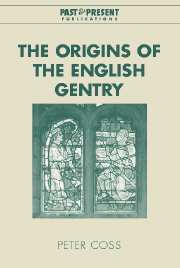Book contents
- Frontmatter
- Contents
- List of illustrations
- Preface
- 1 The formation of the English gentry
- 2 The roots of the English gentry
- 3 The Angevin legacy: knights as jurors and as agents of the state in the reign of Henry III
- 4 The crisis of the knightly class revisited
- 5 Knights in politics: minor landowners and the state in the reign of Henry III
- 6 Knighthood, justice and the early Edwardian polity
- 7 The explosion of commissions and its consequences
- 8 Identity and the gentry
- 9 Knights, esquires and the origins of social gradation in England
- 10 Crystallisation: the emergence of the gentry
- Appendices
- Bibliography
- Index
- Past and Present Publications
7 - The explosion of commissions and its consequences
Published online by Cambridge University Press: 10 December 2009
- Frontmatter
- Contents
- List of illustrations
- Preface
- 1 The formation of the English gentry
- 2 The roots of the English gentry
- 3 The Angevin legacy: knights as jurors and as agents of the state in the reign of Henry III
- 4 The crisis of the knightly class revisited
- 5 Knights in politics: minor landowners and the state in the reign of Henry III
- 6 Knighthood, justice and the early Edwardian polity
- 7 The explosion of commissions and its consequences
- 8 Identity and the gentry
- 9 Knights, esquires and the origins of social gradation in England
- 10 Crystallisation: the emergence of the gentry
- Appendices
- Bibliography
- Index
- Past and Present Publications
Summary
It is time now to examine the explosion in commissions from the 1290s onwards, the development of a real partnership between the crown and county knights in terms of control of the populace, and the extension of that partnership to involve a broader local elite. We will then be in a position to understand the combination of factors which allowed the gentry to crystallise during the first half of the fourteenth century.
THE EXPLOSION OF COMMISSIONS
Although they continued to function as justices of gaol delivery, and very occasionally as tax collectors and the like, during the early years of the Edwardian polity there were not in reality very many high-level tasks for the county knights to perform. The full consequences of the rise of a more elite knighthood were masked as yet by the paucity of tasks which appealed to their elevated status.
This was to change with the explosion of commissions which began in the last two decades of the reign of Edward I. The major factor in this change was undoubtedly the impact of war. Taxation on personal property had returned with the twentieth of 1269, and Edward I levied further subsidies in 1275, 1283 and 1290. But, as Richard Kaeuper has remarked, ‘once across the mid-1290s’ dividing line, the change was marked'. Six taxes were raised during the last fourteen years of his reign, and the pace continued through the reign of Edward II and into that of Edward III. More than a score of subsidies were raised between 1294 and 1340.
- Type
- Chapter
- Information
- The Origins of the English Gentry , pp. 165 - 201Publisher: Cambridge University PressPrint publication year: 2003

